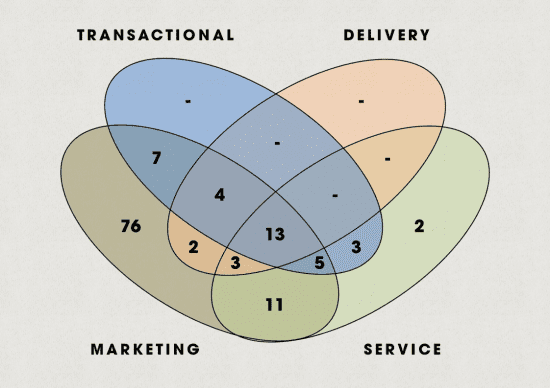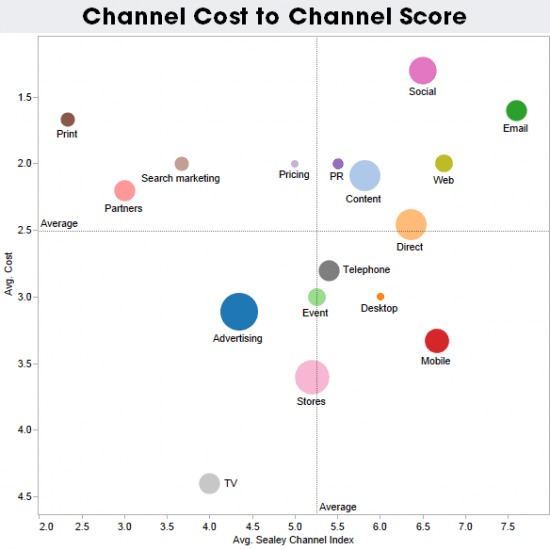Which channels matter most today? An analysis of the effectiveness of 40+ marketing channels
Several months ago, I created a simple spreadsheet of 40+ marketing channels available to marketers to reach and influence consumers today. I shared this on the Smart Insights blog and readers added to my base list - thank you for the recommendations! In this article, starting with the original channels, I've added attribute data about each channel to provide a better picture of channel versatility, cost, purpose and function.
This blog post will cover an analysis of a new all channel spreadsheet available via my site to determine which are the best channels for functionality and value.
Cross-functional channels
Venn Diagram
The four segments in this Venn diagram show the functional intersections for channels used for different types of customer interactions. The four functional categories are:
- Marketing, can the channel be used to market to customers?
- Service, can service and support be provided through this channel?
- Transaction, can the customer pay for goods through the channel?
- Delivery, whether digital or physical, can the customer receive their goods through this channel?

It should be no surprise to discover that of all the channels, the majority serve a marketing purpose. Depending upon your opinion it could be argued that everything a business does is marketing (fulfilling the brand promise) and therefore all channels are marketing.
At the centre of the Venn diagram are 13 channels that can be used for Marketing, Service, Transactions and Delivery. These 13 cross functional channels are:
- Mobile, tablet, wearable tech and desktop apps:
As my daughter has proven to me, it's very easy to buy add-ons for the iPad dressing up game she plays. Apps are well suited to both transaction and delivery. Similarly this principle applies to buying extended licenses in mobile, tablet and wearable apps. Service and marketing can also be delivered to the channel user through the channel. Amazon's new Mayday button on the Kindle HDX being a great example of service delivery through a tablet app.
- Stores, pop-up stores, street vendors and concessions in larger stores:
Physical stores or locations are ideal for marketing to customers, selling product, providing service and then placing goods in the customer's hands. Obviously the human component of a sales rep should not be forgotten.
- Websites including microsites and mobile websites:
Websites provide customer's with the ability to discover new goods, purchase them, take delivery of digital products and also get the support they need. Microsoft and Adobe have both shifted their distribution model to direct sales and delivery over the web.
- Partner sales:
For manufacturers who aren't able to engage with the end customer, partners can provide a powerful way of reaching, selling to, servicing and delivering to the customer. Niche software vendors grow their market in this way, requiring end users to engage with them through a services partner.
- Door to door sales:
The golden age of door to door vacuum cleaner salesmen is not dead. Well trained representatives going door-to-door could provide a complete channel to market, sell, deliver and service goods.
Best value channels
In creating this all channel list, I've also created a scoring mechanism based on how flexible, scalable, functional and engaging a channel is. This score (the Sealey Channel Index) has been plotted against the relative cost grouping for each channel to create the chart below. 4 X 4 matrices like this are a good way to assess channel effectiveness within a multichannel retail business too since you will have data on sales volume, revenue and profit by referrer source (e.g. last click against attribution across multiple channels).

Y axis; relative cost. X axis; Sealey Channel Index score. Size of each bubble; number of channels available within the group
Those groups in the top right are channels that offer a high degree of versatility and engagement for a great price. Those in the bottom right are typically above the line, mass media channels such as TV or radio advertising.
In terms of efficiency, I'd recommend marketers look hard at engaging or optimising these channels (in order):
- Email; highly personalised, easily measured and can be used across marketing, service, sales and even delivery. A real workhorse channel that gets neglected
- Social; engaging, scalable and allows marketers to build tribes of brand advocates. If its done well, there are big rewards to win.
- Web; a highly personalised, engaging, measurable and functional channel for reaching customers. It's at the heart of digital experiences.
- Content; content can be sold to customers, used to support them and help them discover your brand.
Get the whole data set
So far I've documented 126 channels. I expect this list to evolve and grow over time. As it does I'll be sure to keep this post updated with further findings.
For your own projects and strategy there are two versions of this data available:
The original basic list on Google Docs. For those wanting more detail, an advanced list is available from my blog: All channel Excel download
I'd welcome your thoughts and feedback on this list as it represents a lot of time consuming work and research to compile.









